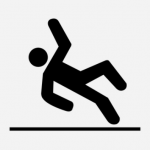Watch Where You’re Going!
Preventing Slips, Trips, and Falls
I recently spoke with Donald Burr, Safety and Training Coordinator for the Professional Logging Contractors (PLC) of Maine, about the hazards of slips, trips and falls when you’re out in the forest. The guidelines Burr shared with me all translate into being safe wherever you are and whatever you do.
Ice and snow are among the hazards that foresters, farmers, and everyone else faces as winter closes in. In recent winters, many snowstorms have ended up as rain. The rain freezes and then we are faced with navigating a sea of skating rinks. Simply trying to walk can pose hazards.
Pay attention and look ahead at where you’re going
What are you wearing on your feet? In icy conditions, wear ice crunchers or microspikes to provide grip and prevent falls. They can be a nuisance to put on and take off but consider this: a friend of mine was walking from her car through the parking lot to get to work. In that short distance, she fell on the ice and ended up with a broken leg. Six months after the fall she was still in pain.
Luckily she didn’t fall and hit her head. Ice and pavement are hard and unforgiving. A crack on the head can cause mild to severe head injuries. Such an injury can take years to heal. Local Maine news anchor Kim Block sustained a traumatic brain injury when she fell on the ice last winter. She shared her story is on the Brain Injury Association of America website.
Make sure the way forward is well-lighted
Loggers often arrive at the job site in the dark. Besides ice and snow, the terrain is going to be uneven, with roots, sticks, wet leaves, rocks, puddles, perhaps even oil from machinery leaks just waiting to trip a person up. Protect yourself from falls with a good headlamp and sturdy footwear.
Back at home
On the farm or in the house–wherever you go, into a shed, barn, hallway, stairway, or bathroom–the area needs to be well-lighted. A child’s truck, a tool left on the floor, or laundry that was folded and left on the stairs become a tripping hazard when you can’t see them. Any of these items tripped over in the dark, could cause a nasty fall.
One step at a time
Walk mindfully when going up and down the stairs. Do not run! Gravity is not on your side if you trip going down the stairs. Stairways need to be well-lighted, with light switches at the top and the bottom. Stairs need to have railings, preferably on both sides, with the railings running all the way to the bottom step. Does that sound like a no brainer? Unfortunately, railings often stop before the last step, which leaves a person at risk of falling when the expectation is otherwise. You need to see where you are going. Don’t obstruct your vision by carrying too many things when going up and down the stairs.
Earn the good housekeeping seal of approval!
Clutter is a tripping hazard. Leave nothing on the stairs, even if you intend to take the items upstairs the next time you go up. Someone could come down the stairs before you get to it.
Tools need to be hung up or put away on shelves. You will save much time and aggravation because you can find tools when you need them and they will not be cluttering the floor where they can be tripped over.
No matter what occupation you pursue, but particularly with logging, farming, and fishing, safety is always key to staying safe and avoiding accidents that can be devastating to you and your ability to make a living.
